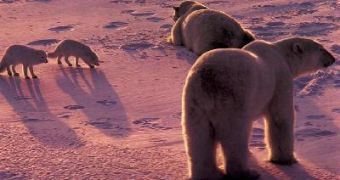Can it be that simple: no ice, no polar bears?
In the International Polar Year (IPY), Norwegian researchers at the University of Tromso will start four projects investigating how climate change due to global warming affects Arctic's predators, like the the Arctic fox, now an endangered species. "We will collaborate with several researchers from the Norwegian Polar Institute and the University of Moscow," says lead researcher Professor Nigel Yoccoz.
The researchers point out that the Arctic fox's habitat, the Arctic tundra, is in a hairline balance, being extremely weak faced to climate change. "Research on ecosystems is complex as it deals with dynamics in all living species in interaction with each other and with non-living aspects of their environment. One of the objectives of this project is to examine whether it's possible to create a simplification by using the predator community as an ecosystem indicator", said co-researcher Professor Rolf Anker Ims.
Typical tundra predators are the Arctic fox, snowy owl, rough-legged buzzard and three species of Arctic skua, which are the most vulnerable to small changes in the prey population.
They can completely stop reproduction when food is scarce. "The Arctic fox is being utilized as the key species in this research project because it is found through the tundra area, as well as being in clear decline in many areas. The Arctic fox population is on the decline in particular in the southern part of the tundra and in the Scandinavian high mountains. It is in danger of disappearing from Norway", said Ims.
"We will carry out field work from Svalbard in the north via the Varanger Peninsula in East Finnmark in Norway to several places in Northern Russia. We will look at the geographical variations in the predator population and compare our findings with those in an equivalent research project in Canada and other parts of North America, which we are co-ordinated with through IPY", said Yoccoz.
In the '90s, there were thousands of Arctic foxes in Norway; now they are less than 100. "We know that the Arctic fox and many other tundra predators completely stop breeding in the years when there are few lemmings. We also know that in a good lemming year as many as 16 Arctic fox cubs can be born into a litter. This means that the species can continue even though it does not reproduce for three to five years. However, if the good lemming years are few and far between, it could be catastrophic for the Arctic fox.", said Yoccoz.
The base of the food chain in the Arctic for all medium sized carnivores are the lemmings, with a significant effect on the whole tundra ecosystem, from vegetation to predators.
The effects on vegetation require more time to be seen, but the predators react quickly to their shortage. "It appears that the good years for lemmings are becoming rarer with global warming. This can result in the Arctic fox and snowy owl, two of the most characteristic species in the Arctic, disappearing from the tundra." said Ims. "The Arctic tundra can be particularly vulnerable. There is a relatively narrow strip between the northern forest and the Arctic sea areas. If the scenarios for climate change are correct, the forest can in time stretch right out to the coast and completely consume this unique ecosystem.", he added.
The warming climate is favoring the Arctic fox's direct competitor, the red fox. "Other Arctic specialties among predators such as the long-tailed skua and the snowy owl can disappear and be replaced by species including the golden eagle.", Yoccoz said.

 14 DAY TRIAL //
14 DAY TRIAL //